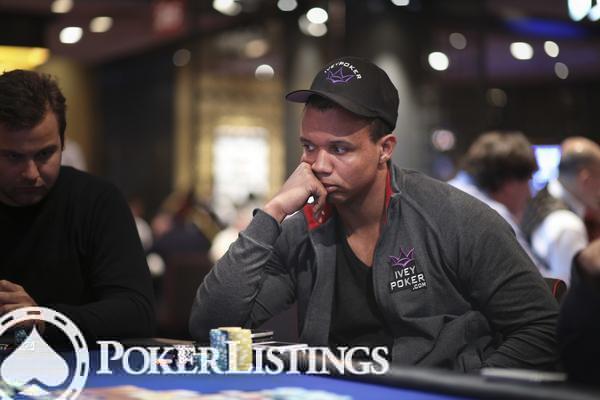Hand of the Week: Haxton Gets Clipped by Ivey At His Best

-
T&Cs Apply | Play Responsibly | GambleAware
18+ | Play Responsibly | T&C Apply
-
T&Cs Apply | Play Responsibly | GambleAware
T&Cs Apply | Play Responsibly | GambleAware

- Fact Checked by: PokerListings
- Last updated on: March 9, 2025 · 4 minutes to read
This week we’re looking at a really precious piece of poker from earlier in the year.
Two of the game’s greats in Phil Ivey and Isaac Haxton engaged in a duel of No-Limit Hold’em and it was a pleasure to rail it.
If you’re a fan of high-stakes cash games you probably followed the huge game that went on alongside the Aussie Millions earlier this year.
Ivey, Haxton, Patrik Antonius, Doug Polk, Paul Newey, Max Altergott, Paul Phua, Richard Yong and Rono Lo took part in the event and turned it into a fantastic poker happening.
Lo and Phua, in fact, played one of the biggest hands ever with $1m in the pot. You can watch that hand here:
Obviously that was an almost stereotypical set-up, so let’s carry on to Ivey vs Haxton because their hand is a lot more interesting from an expert point of view.
From the flop to the river
They were playing $1,000/$2,000 plus a button ante of $2,000. The effective stacks are $257,000. Ivey raises from early position to $6,000. Haxton calls with
K
K
Q
Q
Behind him another four players – Lo, Newey and Antonius and Yong from the blinds – come along for the ride. Six players have now built a pot of $38,000. The flop is
8
8
7
7
2
2
The blinds check. Ivey checks, too, and Haxton semi-bluffs his second-nut-flush draw with a bet of $26,000.
Lo, Newey and Antonius all fold but Yong and Ivey call. The pot is now $116,000 and we see the turn come
3
3
Yong and Ivey check again. Haxton carries on with a bet of $75,000. Yong gets rid of his hand but Ivey moves all-in for $225,000 after some thought.
Haxton gives it a lot of thought before he finally folds his draw. As we could see on the monitor, Ivey held
A
A
A
A
Hand Analysis
This hand between two of the strongest No-Limit Hold’em players in the world begins rather unusually.
Even at very loose tables you rarely see five players call a raise; even less so when the raise comes from Phil Ivey.
On the flop Ivey doesn’t c-bet but decides just to check. Good for him that Isaac Haxton takes the chance to semi-bluff with his draw and overcards.
Haxton’s bet thins out the field and only Ivey and Yong, who is holding A♠ 4♠ and draws to the nuts, stay in the hand.
The 3♣ on the turn is a total blank. All players can be pretty sure this card did not improve the others‘ hand.
Yong checks again and so does Ivey. Haxton takes another go at the pot and bets $75,000. Yong, sandwiched between Ivey and Haxton, gives up his hand.
This is a disciplined and pretty surprising fold. This is complete speculaion but tetraphobia (being afraid of the number 4), which is very common in Asia, might be part of the reason why he did that.
It would have been an interesting twist, had Yong made a move on the flop with his nut flush draw, because then Ivey would have sat between the bettor and the raiser and he would have faced a difficult decision for his whole stack.
But the way the hand went down, Haxton did most of the work for Ivey. He gets rid of all the players and then folds to Ivey’s check-raise. That check-raise is a creative move that also feels a little odd at first glance.
However upon closer analysis, if you look at Haxton’s range, the move is actually very strong. Haxton’s range covers three types of hands — if we leave out the possibility that Haxton is a complete lunatic who would bluff into five world-class players.
The three groups are sets (88, 77 or 22), overpairs (99-KK) and draws (flush, open-ended straight or a combo draw).
Apart from the sets, which are the most unlikely group as there are only three possibilities, Ivey is ahead against everything else and can still get called by a lot of worse hands — overpairs in particular.
Against the draws Ivey’s check-raise protects his hand and maximizes his winnings because he lets Haxton bet first.
Haxton shows his class, too, on the river. He thinks about it but then acknowledges that he has to fold, despite getting pot odds of 416,000 to 150,000 or 2.77 to 1.
He’s a 4-1 underdog against Ivey’s aces but he’s also behind against the other hands in Ivey’s range (a better flush draw, overpairs, sets).
Phil Ivey at His Very Best
Phil Ivey has not peaked; he’s at his very best right now. He plays pocket aces unconventionally and turns them into a big win.
Isaac Haxton’s brave double-barrel semi-bluff unfortunately doesn’t get the reward it deserves.
Instead, it turned out to be an adventure that cost Haxton more than $100k.
-
Stake.US Poker4.3
- Rakeback 5%
- $55 Stake Cash + 260K Gold Coins
T&Cs Apply | Play Responsibly | GambleAware
18+ | Play Responsibly | T&C Apply
-
Appeak Poker4.1
- 1,000 Chips Daily
- FREE 5,000 Chips
T&Cs Apply | Play Responsibly | GambleAware
T&Cs Apply | Play Responsibly | GambleAware
-
- 2,500 Gold Coins + 0.50 Sweeps Coins
T&Cs Apply | Play Responsibly | GambleAware
18+ | Play Responsibly | T&C Apply
-
WSOP.com4.3
- Up to 70%
- 100% up to $1000
T&Cs Apply | Play Responsibly | GambleAware
T&Cs Apply | Play Responsibly | GambleAware
-
CoinPoker4.1
- 33% Weekly
- 150% up to 2000$
T&Cs Apply | Play Responsibly | GambleAware
+18 / T & C apply / Play responsible

